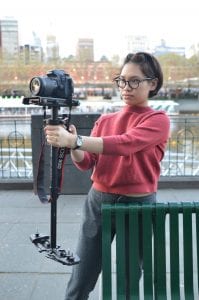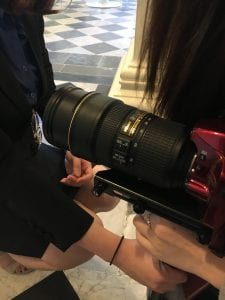
The entirety of Film Project One was enlightening and educational – I learned a lot from it and it most definitely broadened my experience when it came to filmmaking. I was always curious as to how films were made when watching them, but now, I’ve delved into it after getting to experience this film production with my group members and myself. The whole process of pre-production, production and post-production. This is the three main steps of how you make any type of film, whether it be indie, Hollywood or a student short film. There are also a variety of inspirations that came behind Missed Moments, which I will further discuss in the upcoming paragraphs.
Scriptwriting is one of the first few aspects that I want to dissect and discuss. I have never had the opportunity to write an “official” script from a production and have mostly been for myself during drama classes in high school and was all written informally or wasn’t up to industry standard. For this assignment, however, I actually went out and researched how to professionally write a script, with the correct format and structure. What I got out from the scriptwriting process is that it is the first and official part of making a film. When we had our session with Arthur, he said that a film is made three times. First through script writing, second during the acting and third, when editing. Through this script, I was able to visualise how each and every scene would look, especially because I was mostly describing it through the character’s actions and emotions. The script also enabled me to get to the editing process because in a script, you are able to add in transitions such as “fade” or “cut”, and that can be done in Premiere Pro through the effects.
Now, I have mentioned quite a few times that there will be little to no dialogue. In the final cut, the three lines in the whole short film ended up being:
- “Sorry”
- “It’s okay”
- “It’s nice to meet you”
I made it this way so that it would be easier for us to work with less audio and because, in a way, it is a film technique. To me, I feel it is more impactful to have subtitles over a video without hearing the actual words being spoken. That way, there is an affirmation to the words being spoken and we know for a fact, that the subtitles are always true to the storyline. My inspirations behind using a yellow font subtitle was from the film, Eat Drink Man Woman (1994) and several other films that use the classic yellow, Arial font. Of course, the subtitles were only present because the language being spoken was in Mandarin but in our case, it is English. Why would one need subtitles for English? I think that watching something being spoken with subtitles over it gives it a more dramatic mood and tone.

I’m not exactly sure what the origins of the yellow subtitles are but I know for a fact that yellow is used because it is easier to read no matter what type of background the subtitle is in front of. I wanted to replicate that type of aspect from films to add a touch of authenticity and of course, for the whole aesthetic and meaning of Missed Moments as part of the Asian cinema context.
Now during production, a lot of the process was discussed over our group chat and through video calls. A lot of this was done in the week of shooting because we had to match our schedules with each other and the actor – a lot of changes were made in comparison to our original plan of the whole production. I initially wanted to finish the whole production process within a week over the mid-semester break, preferably over two to three days but ended finishing it over four days, in a non-sequential order. We had breaks in between because we had to work around our commitments. Despite all of this, the production process went quite smoothly and there was really no other major issue when it came to working with Joanna, Pavina or Aaron. Everyone cooperated well and exposed to the type of attitude and behavior you need to have when it comes to working with people in the film industry. Before the whole process, Joanna and Aaron also signed release forms because they were going to be on camera and might be possibly exposed to the public.
For the editing process, I was in charge of editing two scenes which were the Southern Cross and the Chinatown scene. Let’s talk about Chinatown. I want to deeply discuss this because I think it embodies my whole aim for this course: Asian Cinema. Like mentioned in our film pitch, we were heavily inspired with the cinematography of In the Mood for Love so therefore, we wanted to use the red lighting as a source of light and put in the same detail that that film had. The film represents the character’s moods and feelings without explicitly showing it. The way it is shown is through the visuals and the musical score. It is depicted so well through externally (the director) that their actor and actress only maximises the film as a whole. I envisioned our short film to have the same sentiment, which is why I chose to have as little dialogue as possible. Of course, there is only so much you can do with a low budget production so we tried to replicate it to the best of our abilities. The scene that we tried to emulate was all in the work of Christopher Doyle, who has mentioned that it is a “compendium film”, meaning that it is a collection of concise information about a certain subject. He has perfectly depicted it by getting every single piece of angle that we could have never thought of. From the text, “Puzzle Films: Complex Storytelling in Contemporary Cinema”, there is a repetition in the form, themes and styles that contribute to the overall storytelling of In the Mood for Love. Had we had more time, money and resources, we could have replicated the whole storytelling of Wong Kar-Wai through cinematography, but at this moment, our attempt of his work and Asian Cinema as a whole is on a student and amateur level of his work.
As a whole, my technical and creative development has definitely advanced in comparison to a month ago. I learned a lot of techniques and the overall process of how to make a film: pre-production, production, post-production and screening. Beyond screening, I believe the film is still growing with you and as time goes by, the way you see your own work in the future is a proof of growth. You may it view differently a month from now compared to how you see the film today. My technicality and creativity has definitely advanced in the sense that I know a lot more through experience. Now, it is a just a matter of getting more experience and exposure in the film industry.
References:
Eat Drink Man Woman (1994), produced by Hsu-Li Kong, Taiwan (distributed by The Samuel Goldwyn Company, 1979), 123 minutes
In the Mood for Love (2000), produced by Wong Kar-Wai, Hong Kong (distributed by Universal Pictures, 1912), 98 minutes
W. Buckland, Puzzle Films: Complex Storytelling in Contemporary Cinema, 1st Ed., (Wiley, UK, 2009), p. 183
 The only real challenge was maintaining our stamina as we had to shoot across different locations. By the third location, we were all starting to get tired – we started filming at one in the afternoon and finished filming by eight in the evening.
The only real challenge was maintaining our stamina as we had to shoot across different locations. By the third location, we were all starting to get tired – we started filming at one in the afternoon and finished filming by eight in the evening. own lamp to the shoot and used a red, see-through film over it to produce a red tinge. It was a practical and effective way to get rid of the shadows but I’m not sure if it actually executed the shot that we wanted. Nonetheless, it was still a great attempt to add in effects and stylise the whole shot.
own lamp to the shoot and used a red, see-through film over it to produce a red tinge. It was a practical and effective way to get rid of the shadows but I’m not sure if it actually executed the shot that we wanted. Nonetheless, it was still a great attempt to add in effects and stylise the whole shot.





































